- Tomasz Rydelek
In early June, the Ukrainians launched an offensive in the Zaporizhia region. At first glance, the Russians seem well-prepared for defence. They have built an extensive system of fortifications along the entire front line, which in some sectors extend as far as 35 km into the occupied territory. Moscow also often enjoys air superiority. But this is only one side of the coin. The 'Russian colossus' in Zaporizhia has legs of clay. A major problem for the Russian Federation's armed forces is logistics. Heavy reliance on rail transport means that the Ukrainians, to defeat the Russians, do not necessarily need to destroy the army's regular troops. To succeed in Zaporizhia, it is enough to starve Russian logistics.
Logistics and defeat at Kyiv and Kherson
The commander of the American expeditionary corps in Europe during the First World War, General John Pershing,once said: ‘Infantry wins battles, logistics wins wars'. The experience of the fighting in Ukraine shows that this quote has lost none of its relevance.
It is logistics that set the limits of Russian success. We saw this in the early days of the war. Russian tanks - especially east of Kyiv - penetrated deep into Ukrainian territory. But the failure to secure logistical hubs meant that in the long run the Russians were unable to resupply their forces and had to withdraw from north-eastern Ukraine.
An even better example, illustrating how logistical problems affect Russian operations is the Battle of Kherson. The Russian bridgehead at Kherson was supplied by 3 crossings on the Dnieper river: two bridges in Kherson (road and rail) and a bridge over the dam at Nova Kakhovka. In July 2022, the Ukrainians began systematically attacking these crossings, eventually putting them out of action. The Russians tried for several months to supply the bridgehead using ferries and pontoon bridges, but this was only a makeshift solution. As a result, the Ukrainians starved Russian logistics to such an extent that General Sergei Surovikin had no choice but to surrender Kherson in November and withdraw Russian troops to the other bank of the Dnieper.
Russian Railway Troops
Rail transport plays a key role in Russian logistics. Alex Vershinin, a retired US Army lieutenant colonel, summed it up as follows:
Russian forces are tied to railroad from factory to army depot and to combined arms army and, where possible, to the division/brigade level. No other European nation uses railroads to the extent that the Russian army does.
This dependence on the railways has far-reaching consequences. Russians had to establish Railway Troops of the Russian Armed Forces, which is a separate branch of Moscow’s forces, comprising up to 10 brigades and several independent battalions. In total, there are almost 30,000 soldiers. Their main task is to ensure uninterrupted rail transport for the army, including the repair of damaged railway lines and bridges.
As the Swedish Defence Research Agency notes, the Russians' dependence on rail transport makes the Russian military's plans very predictable. Russians simply have to move along railway lines. This makes their troops very vulnerable to damage to key rail links, especially bridges.
The challenge for the Railway Forces is not only the activities of Ukrainian saboteurs in the Russian rear, but also Kyiv's possession of long-range weapons, e.g. HIMARS launchers with GMLRS ammunition or Storm Shadow missiles, which can be used to strike targets without physically approaching them.
The Russians face a particularly problematic situation in Zaporizhzhia, where the rail network is very limited. There are several potential bottlenecks along the train routes, the failure of which could paralyse all Russian logistics in this part of the front.
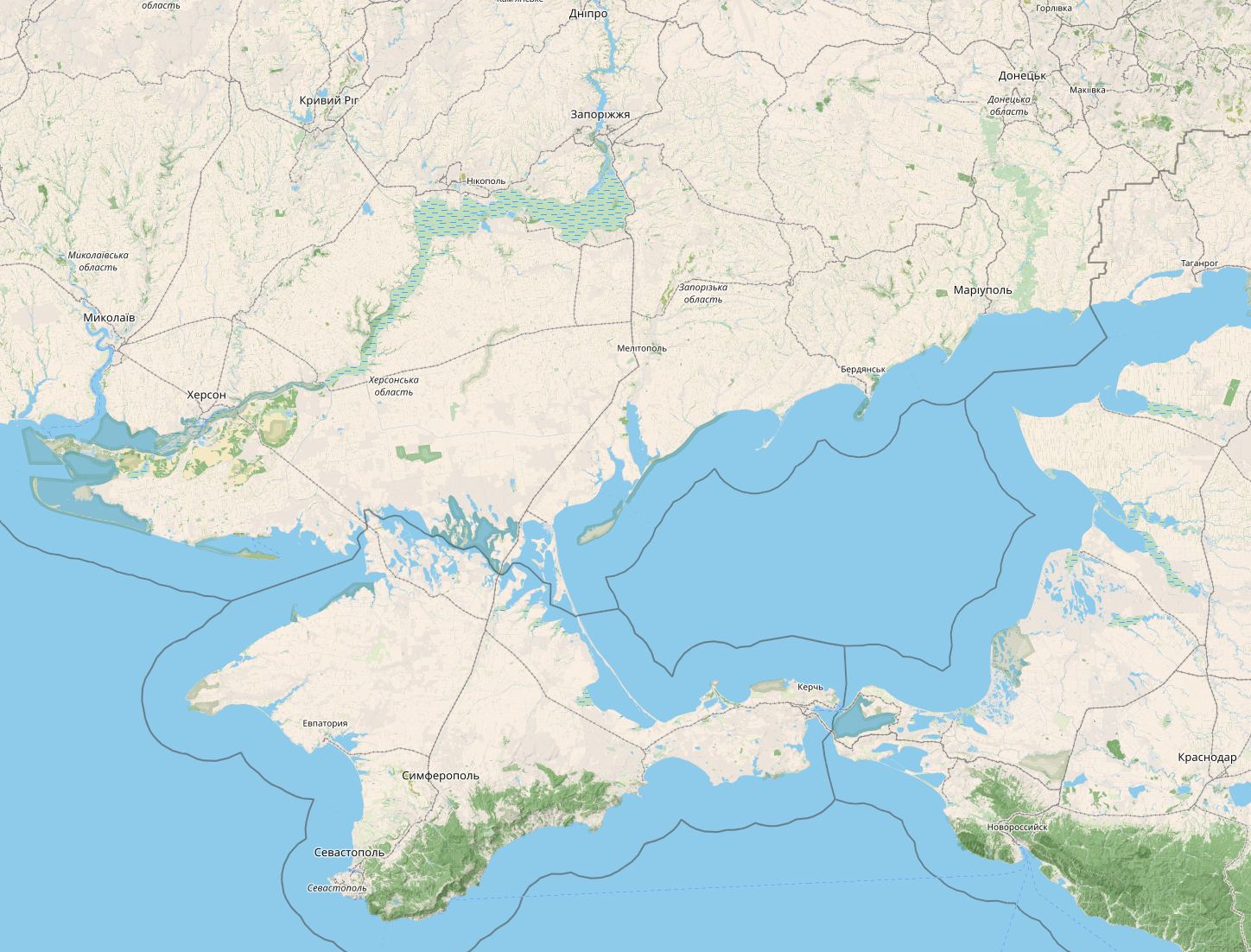
To best understand the Russian situation in Zaporizhia, it is necessary to start with the characteristics of the Russian fortifications. The open spaces in Zaporizhia and the lack of natural barriers make the terrain extremely difficult to defend (especially as the front line in Zaporizhia stretches for some 170 km or over 100 miles).
In order to secure their positions, the Russians have built a complex system of fortifications in Zaporizhia, consisting of 2 (and in some places 3, 4) lines of defence extending 15 to 35 km into the occupied territory. On the other hand the area between the successive defence lines, is densely mined.
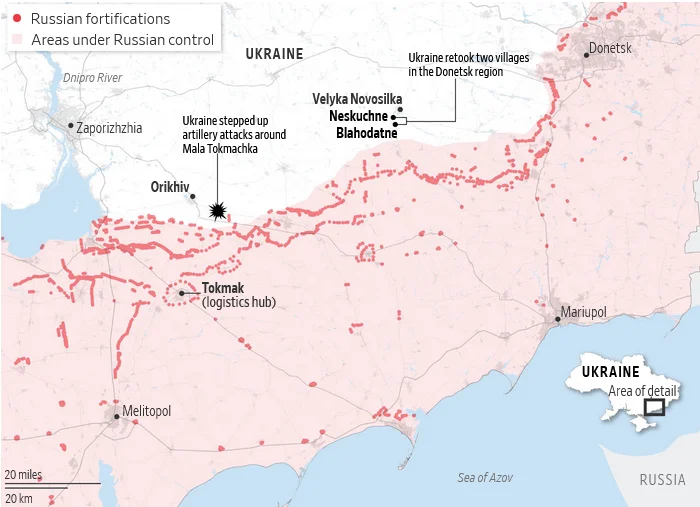
The Russians do not limit themselves to defence. If a Ukrainian attack is successful in one place, the Russians immediately launch a counter-attack to compensate for the results of the Ukrainian actions or to cancel them out altogether. Counter-attacks are costly for the Russians, but they are also very important. The Russians’ main aim is not necessarily to retake territory but to knock the Ukrainians 'out of rhythm', creating chaos and making it difficult to launch further attacks.
The extent of the Russian preparations for the defence of Zaporizhzhia is best illustrated by the fact that they also prepared fortifications at the rear of the main defensive lines. The towns of Tokmak (25km from the front) and Kamjanka (35km from the front) were converted into 'small fortresses' and prepared for encirclement. These two towns are of great strategic importance to the Russians. Unsurprisingly they are crossed by the railway line - in fact the only railway line in the region connecting Zaporizhia to Russia (via Crimea).

As in other sectors of the front, the Russian forces in Zaporizhia are mainly supplied by rail. Supply trains from Russia cross the Crimean Bridge, pass through Melitopol and then reach the railway junction at Nova Bogdanivka (west of Tokmak). From here, trains can head west (to Kachovka) or east (to Volnovakha). Russian logistics in Zaporizhzhia are further supported by the port of Berdyansk and road transport from Donetsk.

Crucial to understanding the situation is that the Russians do not have a direct rail link between the Zaporizhzhia region and Donetsk. Trains from Rostov-on-Don to Melitopol, for example, cannot go through Donetsk but must take a detour through Crimea. This is because the Russians have failed to fully secure the railway line between Volnovakha and Donetsk - in some places the front line is only 5km from the railway line, making safe transport impossible.
During the winter, the Russians wanted to strengthen their logistics and tried to take Vuhledar. Had it fallen, the Volnovakha-Donetsk railway line would have been thoroughly secured, giving Zaporizhzhia region a direct rail link to Donetsk. However, after several weeks of heavy fighting for Vuhledar, the Russians finally suffered a humiliating defeat, including losing the 155th Marine Infantry Brigade and more than 100 pieces of heavy equipment. According to unofficial sources, the commander of the Eastern Military District, General Rustam Muradov, 'paid the price' for this defeat and was dismissed from his post.
Russian Dilemma
At first glance, the Russians may appear to be in a very comfortable position in Zaporizhia. They are separated from the Ukrainians by two complex lines of defence, while the key cities in the Russian rear are prepared for a long encirclement.
At the same time, however, the Russians' reliance on rail transport, combined with the limited rail infrastructure in Zaporizhia and the lack of a direct rail link to Donetsk, makes Russian logistics on the southern front very fragile.
Damage to the Crimean Bridge means immediate supply problems for Russian troops in Zaporizhia. The Crimean Bridge has been the target of a Ukrainian attack before, in October 2022. Despite the damage, it was not completely taken out of service and was reopened in early May 2023. The Russians reported that the railway section of the bridge had been restored to its pre-attack condition.
The Crimean bridge is by far the most sensitive point in Russian logistics. But it is not the only supply bottleneck. Trains from Crimea to Melitopol have to cross the Syvash, a system of shallow water bays that separates Crimea from the Kherson region. There is only one railway bridge across the Syvash. If the Ukrainians successfully destroy it, the effect would be similar to the removal of the Crimean Bridge.
However, it should be noted that the Sywash is relatively shallow. Its average depth is around 1 meter. Repairing the bridge over the Syvash would therefore be much easier than the Crimean Bridge.
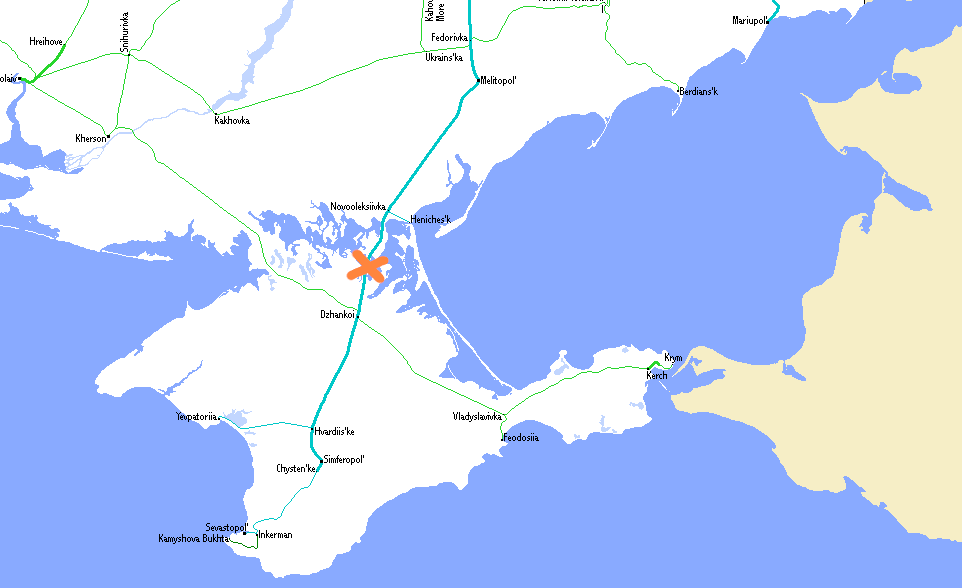
If the Ukrainians do not disable the Crimean Bridge or the bridge over the Syvash, they will face a challenging combat at Zaporizhia. In fact, if the rail link to Crimea remains operational, the only significant threat to Russian logistics will be if the Ukrainians occupy the rail junction at Nova Bogdanivka (west of Tokmak). However, this junction is some 50km from the front line. In order to reach it, the Ukrainians would first have to overcome up to four Russian defensive lines.
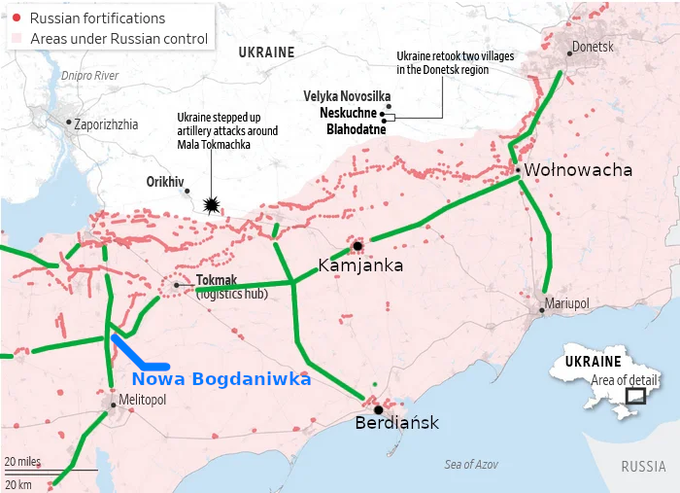
There is also a second option for attacking Russian logistics. The Ukrainians could try to strike the railway junction at Verkhny Tokmak (between Tokmak and Kamjanka, two Russian 'fortresses'). The junction is 10km closer to the front line than Nova Bogdanivka. There is also no information that the Russians have fortified Verkhnij Tokmak.
It might therefore seem the ideal place to attack and drive a wedge into Russian positions. But it is not that simple. After all, seizing the Verkhny Tokmak junction will not paralyse Russian logistics in western Zaporizhia (trains will still be able to reach Tokmak), while the Ukrainians will find themselves between two strong Russian groupings that would certainly attempt a counterattack, either from the west or the east.
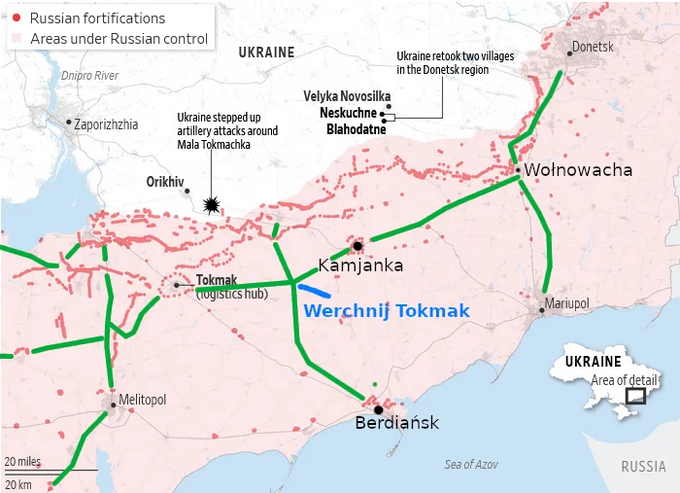
Ukrainian attacks on Russian hinterland
The Ukrainians are conducting their operations in Zaporizhia in a two-pronged manner. They are constantly looking for weaker points in the Russian defensive lines, hoping eventually to gain a local breakthrough and enter the Russian rear. At the same time, however, the Ukrainians are relentlessly trying to cripple the enemy's logistics in Zaporizhia, consistently striking at the Russian rear.
On the night of 17-18 June, Ukrainians destroyed a Russian ammunition depot in the village of Rykovo, some 140km from the front. The explosion was so powerful that it damaged the railway tracks passing by, and let’s remember - Rykovo is on the Crimea-Melitopol route. Railway troops moved quickly to repair, but the Russians still lost the rail link between Crimea and Zaporizhzhia for at least a few days.
A couple of days later, on 22 June, the Ukrainians damaged the road bridge at Chonhar, over Syvash, through which the shortest route to Zaporizhzhia runs. This doubled the route of trucks heading from Dzhankoy in Crimea to Melitopol, from 150 to 300 km.
During the 22 June attack, however, the Ukrainians failed to disable the railway bridge over the Syvash, located 7 km to the west. Yet it remains only a matter of time until the Ukrainians make another attempt to destroy it.
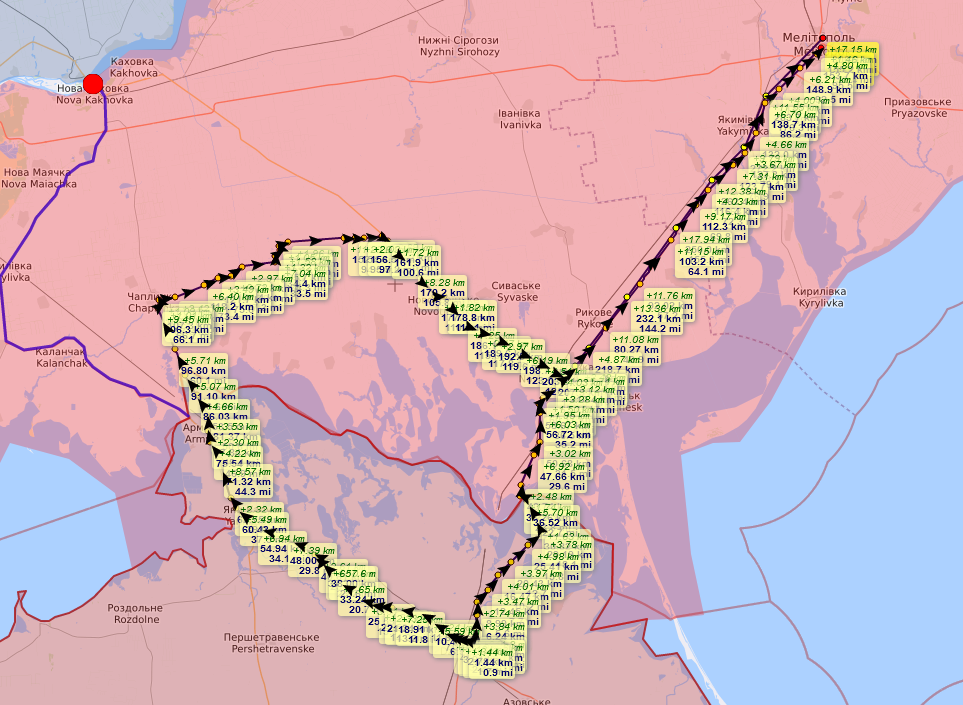
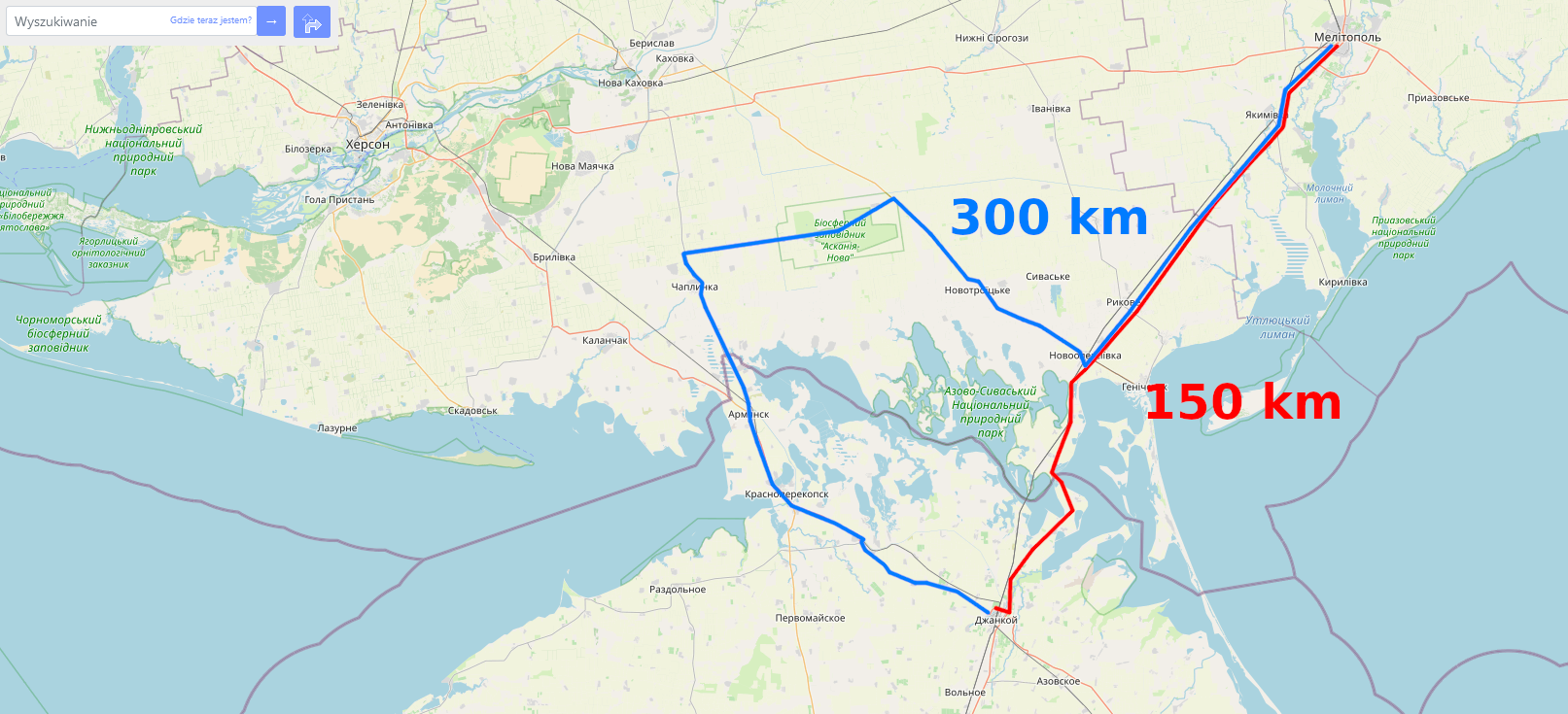
The Ukrainian offensive in Zaporizhia began in early June and has so far failed to make any significant territorial gains. The main reason for this is the extensive Russian fortification system and Russian air superiority.
Russian propagandists readily use photographs of Ukrainian losses in Zaporizhia as evidence of the failure of the Ukrainian operation. Eagerly used are photographs of the destroyed Leopard tanks that Kyiv received from Western countries.
Still, these are purely propaganda ploys. The Ukrainian staff had no illusions that the summer offensive would be as quick as the Kharkiv or Kherson ones. Everyone knows how complicated this operation is, and the time horizon is set not for weeks, but for at least several months. Why? Well, again - because of logistics.
The destruction of key links, enemy bases and ammunition depots is essential to the success of this operation, but it is a time-consuming process. Kyiv, unlike Moscow, respects the lives of its soldiers and is trying to soften up the enemy's rear as much as possible before the subsequent phases of increased frontline breaching.
So far, the Russians have been able to repair damaged links continuously, but it remains unknown how long this will last. The fact that the Ukrainians have Storm Shadow missiles means that all key road or rail links and the Russian ammunition depots at Zaporizhzhia are at risk. It is possible that Storm Shadow missiles could also threaten the Crimean Bridge.
The challenge posed by degrading the Russian rear show once again how much the Ukrainian attempts to retake the occupied territory are hampered by the lack of American ATACMS missiles and F-16 fighters. These are the perfect means of destroying the enemy's facilities, important ammunition depots and key railway and road bridges. The appearance of ATACMS and F-16 fighters on the battlefield would be a massive problem for the Russians, comparable to the blow that Russian logistics suffered after Kyiv received the HIMARS rocket artillery last year.
Logistics are the key to victory in Zaporizhia. If the Ukrainians will disable the key rail links, the Russian defences will fail and collapse. However, if a rapid crippling of Russian logistics proves impossible, the Ukrainians will face a very difficult struggle through the subsequent Russian defences.





